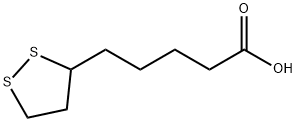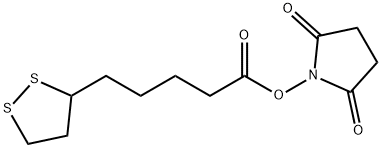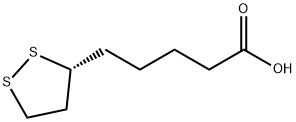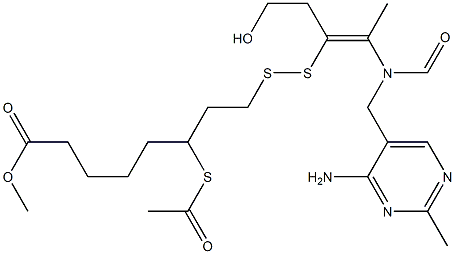Lipoic acid
- CAS NO.:62-46-4
- Empirical Formula: C8H14O2S2
- Molecular Weight: 206.33
- MDL number: MFCD01631142
- EINECS: 200-534-6
- SAFETY DATA SHEET (SDS)
- Update Date: 2025-03-03 11:46:17

What is Lipoic acid ?
Chemical properties
Alpha lipoic acid (ALA) is synthesised enzymatically in the mitochondria from octanoic acid and plays a critical role in mitochondrial energy metabolism. ALA presents as two enantiomers: the R-(+) enantiomer, which is widely present in nature and is biologically active, and the S-(-) enantiomer, which is often included in synthetic-based ALA supplements but is believed to have limited biological activity.
Formulations includes:
R-alpha lipoic acid capsules, tablets, powders or drops
Racemic mixture of R- and S- alpha lipoic acid enantiomers in capsules, tablets, powders or drops
Intravenous administration of R-alpha lipoic acid
History
Alpha Lipoic Acid (ALA) was discovered in 1951. It is a sulfur-containing coenzyme, and when it was first isolated and studied, its main function was thought to be in the Krebs Cycle.
In 1988, ALA was discovered to be a potent antioxidant, and is active in both fat- and watersoluble regions of the cell.
The Uses of Lipoic acid
α-lipoic acid (ALA, thioctic acid) is an organosulfur component produced from plants, animals, and humans. It has various properties, among them great antioxidant potential and is widely used as a racemic drug for diabetic polyneuropathy-associated pain and paresthesia. It has been used in alternative medicine as a possibly effective aid in weight loss, treating diabetic nerve pain, healing wounds, lowering blood sugar, improving skin discoloration caused by vitiligo, and decreasing complications of coronary artery bypass graft (CABG) surgery.
Alpha Lipoic Acid 600 mg | 45 Tablets
Definition
ChEBI: Lipoic acid is a heterocyclic thia fatty acid comprising pentanoic acid with a 1,2-dithiolan-3-yl group at the 5-position. It belongs to a vitamin of the vitaminB complex. Lipoic acid is one of thecoenzymes involved in the decarboxylationof pyruvate by the enzymepyruvate dehydrogenase. Goodsources of lipoic acid include liverand yeast.
Biological Functions
Lipoic acid is a cofactor for five enzymes or classes of enzymes: pyruvate dehydrogenase, a-ketoglutarate dehydrogenase, the glycine cleavage system, branched chain keto acid dehydrogenase, and the alpha-oxo(keto)adipate dehydrogenase. The first two are critical to the citric acid cycle. The GCS regulates glycine concentrations.
Pharmacology
The drug is a cofactor for the pyruvate dehydrogenase complex, ketoglutarate and amino acid hydrogenase complexes. This drug can inhibit lipid oxidation in nerve tissue, prevent glycosylation of proteins, inhibit aldose reductase, and prevent the conversion of glucose or galactose into sorbitol. Animal experiments show that this drug can prevent the development of diabetes, promote the utilization of glucose, and prevent neuropathy caused by hyperglycemia. Lipoic acid is easily reduced to dihydrolipoic acid after entering the human body, both of which can promote the regeneration of vitamin C and vitamin E, and play an antioxidant role. The drug can also increase intracellular glutathione and coenzyme Q10 and chelate certain metal ions.
Side Effects
Alpha-lipoic acid is generally considered safe with little to no side effects. In some cases, people may experience mild symptoms like nausea, rashes, or itching.
Structure and conformation
Lipoic acid contains two sulfur atoms (at C6 and C8) connected by a disulfide bond and is thus considered to be oxidized although either sulfur atom can exist in higher oxidation states.The carbon atom at C6 is chiral and the molecule exists as two enantiomers (R)-(+)-lipoic acid (RLA) and (S)-(-)-lipoic acid (SLA) and as a racemic mixture (R/S)-lipoic acid (R/S-LA).
Properties of Lipoic acid
| Melting point: | 48-52 °C(lit.) |
| Boiling point: | 315.2°C (rough estimate) |
| Density | 1.2888 (rough estimate) |
| refractive index | 1.5200 (estimate) |
| Flash point: | >230 °F |
| storage temp. | 4°C, protect from light |
| solubility | Very slightly soluble in water, very soluble in dimethylformamide, freely soluble in methanol. |
| InChI | InChI=1S/C8H14O2S2/c9-8(10)4-2-1-3-7-5-6-11-12-7/h7H,1-6H2,(H,9,10) |
| CAS DataBase Reference | 62-46-4(CAS DataBase Reference) |
| NIST Chemistry Reference | Lipoic acid(62-46-4) |
Safety information for Lipoic acid
Computed Descriptors for Lipoic acid
| InChIKey | AGBQKNBQESQNJD-UHFFFAOYSA-N |
| SMILES | S1CCC(CCCCC(O)=O)S1 |
Lipoic acid manufacturer
New Products
3-Iodophenylacetic acid 3-Pyridineacetonitrile, α-hydroxy- 2-Propanamine, 1-chloro-, hydrochloride (9CI) 3-(hexyloxy)-4-(pyridin-3-yl)-1,2,5-thiadiazole 2-Hexyn-1-ol Dibenzo-18-crown-6 Nickel(II) perchlorate hexahydrate, 98% 4-Bromophenylacetonitrile, 95% 3-Bromo-4-fluoroaniline, 97% Sodium tetraborate decahydrate, 98% Palladium(II) acetate, trimer, Pd 99% 4-Bromo-2-chlorotoluene, 97% N N Dimethylformamide Dimethyl Acetal (Dmf Dma) 2,3-Dichloro Benzoyl Cyanide [Side Chain] Bis(2-Chloroethyl) Amine Hydrochloride L-Glutamic Acid Diethyl Ester Hydrochloride 5-(Difluoromethoxy)-2-Mercaptobenzimidazole 1-Ethyl-3-(3-Dimethylaminopropyl)-Carbodiimide Hydrochloride [EDC Hcl] 1,4-Napthoquinone Bromoiodomethane Sodium Bicarbonate Methylene Dichloride (MDC) Ethyl Acetate Indole-3-Carbinol (I3C)Related products of tetrahydrofuran








You may like
-
 17604-74-9 3-Pyridineacetonitrile, α-hydroxy- 98+View Details
17604-74-9 3-Pyridineacetonitrile, α-hydroxy- 98+View Details
17604-74-9 -
 131987-69-4 98+View Details
131987-69-4 98+View Details
131987-69-4 -
 2-Hexyn-1-ol 98+View Details
2-Hexyn-1-ol 98+View Details
764-60-3 -
 Cyclohexane, (2-propynyloxy)- 67967-07-1 98+View Details
Cyclohexane, (2-propynyloxy)- 67967-07-1 98+View Details
67967-07-1 -
 764-60-3 2-Hexyn-1-ol 98+View Details
764-60-3 2-Hexyn-1-ol 98+View Details
764-60-3 -
 2-Propanamine, 1-chloro-, hydrochloride (9CI) 98+View Details
2-Propanamine, 1-chloro-, hydrochloride (9CI) 98+View Details
5968-21-8 -
 3-Iodophenylacetic acid 1878-69-9 98+View Details
3-Iodophenylacetic acid 1878-69-9 98+View Details
1878-69-9 -
 132945-75-6 (S)-1-Boc-3-methanesulfonyloxy-pyrrolidine 98+View Details
132945-75-6 (S)-1-Boc-3-methanesulfonyloxy-pyrrolidine 98+View Details
132945-75-6
